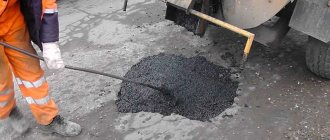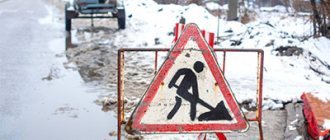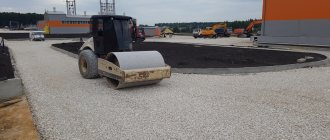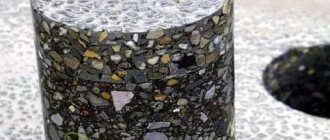Roads are considered the “arteries” of a complex “organism” of any country. The percentage of emergency situations that occur primarily depends on their quality. When designing a road, a number of factors are taken into account: future load from vehicles, natural conditions, proximity to groundwater, and even human economic activity in the area where the roadway is laid. It is not enough just to lay good asphalt; it must be repaired in a timely manner and properly maintained. Well-established transport links provoke the emergence of new settlements or the revival of old ones, the construction of industrial and commercial facilities, as well as the development of human economic and cultural activities. Accordingly, new roads play the role of an active participant in the development of society in various directions. There are several options for laying the road, and the process of its construction is complex and multi-stage. Let's consider whether in reality or not, the technology of asphalting roads is complex.
Types of asphalt pavement
In the production of asphalt mixtures, bituminous materials (resins), as well as reinforcing filler, are used. Its role is played by coarse sand and mineral rocks of a certain fraction. All materials must be of good quality, and depending on the type and purpose of the coating, other ingredients are added to the composition.
Types of asphalt:
First class coatings. They are used for laying routes and can withstand heavy loads. The technology involves the use of mineral filler up to four centimeters in size. Such coatings can withstand the weight of loaded vehicles and intensive use.
- Second class coatings. They are used for paving squares, sidewalks and pedestrian roads. The largest inclusions of the asphalt mixture reach 25 mm.
- Third class coatings. The priority in this case will be the plasticity of the mixture. Mineral particles of minimal size (up to 15 mm), which allows for a tight fit of the composition. This type of coating is used for non-vehicular use (private courtyards, institutional areas, sports grounds).
- Hot asphalt. Its installation technology requires the use of special equipment, as well as compliance with a number of conditions. First of all, this is the temperature of the finished mixture and the ambient air. It is unacceptable to lay cooled asphalt, or to carry out work at sub-zero temperatures. The second important point is the speed of laying hot asphalt. If the work is not performed in accordance with GOST, the quality of the coating will be poor. Hot asphalt is used to lay new roads and sidewalks. After application, the coating should not be used for some time to ensure sufficient adhesion.
- Cold asphalt. Its standards are also regulated by GOST and SNIP, but in production other grades of bitumen are used, which harden faster and do not require a certain temperature. Cold asphalt can be laid in a wider range of ambient temperatures (up to -5ºС is allowed). Most often, this method is used when performing pothole repairs of roads, or to perform asphalt paving on your own.
Proportions and manufacturing standards are regulated by GOST, but many manufacturers ignore this rule and use cheap substitutes. This does not reflect well on the quality of the asphalt mixture, so it is preferable to order this product from truly trusted companies, for example, representative offices.
Application technologies:
You can purchase cold asphalt not only directly from the manufacturer, but also in construction stores. Airtight containers allow you to preserve its characteristics for up to several months. At the same time, in terms of strength and service life, the cold mixture is significantly inferior to the alternative option, so the use on busy roads or places of active use is somewhat limited.
Preparatory work before laying asphalt
An important condition for proper installation is compliance with the requirements of GOST and SNIP for surface preparation. These standards provide for several stages, on which the quality of the future road will also depend.
How to prepare the surface:
- Clear and mark the asphalt paving area. If necessary (swampy areas, possible problems with the soil), geodetic surveys are carried out.
GOST for laying asphalt regulates all possible nuances associated with the implementation of such a coating. This process is complex, because even with special equipment, most of the work still requires manual labor.
How is asphalt paving done?
The rules for laying asphalt mostly depend on the type and purpose of the coating, but some standards cannot be changed. Such rules are clearly stated in GOST and SNIP, and they ensure the durability and quality of future roads and sidewalks.
According to GOST requirements, asphalting of roads and sidewalks must be carried out under suitable weather conditions. The production of the mixture is also determined by the standards of these documents. Laying asphalt SNIP (building codes and regulations) also determines the quality of the finished work, from the stage of preparatory work to the final cycle.
Basic requirements of the standards:
- Immediately before laying asphalt, heated bitumen or bitumen emulsion is applied to the prepared surface.
Laying hot asphalt should be carried out exclusively at positive air temperatures (not lower than 5 degrees).
What characteristics distinguish hot asphalt from cold and cast asphalt?
| Type of asphalt concrete | Strength | Wear resistance | Life time | Moisture resistance |
| Hot asphalt | High | High | High enough | High enough |
| Cold mix asphalt | Average | Average | Average | Average |
| Cast asphalt concrete | High enough | High | High | High |
Rising: average – quite high – high
Final works
After asphalting, a special impregnation must be applied to the section of the future road. It provides tight adhesion to asphalt and gives the coating an attractive appearance.
The following impregnation options are distinguished:
Asphalt emulsion. Among all types, this is the most affordable mixture, but does not always live up to expectations. Most often used for sections of road without heavy traffic or sidewalks.
When choosing a finishing layer, it is worth considering not only the financial issue, but also the main purpose of the project. When choosing a mixture, you need to take into account how intensively the road surface is used.
Creating asphalt pavement is an important process, because it determines the quality and durability of future roads and sidewalks. The classification of mixtures and the application process are determined by the requirements of GOST and SNIP, as well as the types of road work. In order for the coating to last as long as possible even under intense load, it is important to choose a reliable manufacturer. Vertical layout of the site. "Road Technologies" guarantees speed of execution and compliance with all quality requirements.
Asphalting as a way to create a smooth, strong and durable road surface
Careful observations of nature have allowed humanity to learn a lot of useful things from its lessons to make life easier and improve living conditions. This applies to almost all spheres of people’s lives, and modern science, based on such knowledge, has greatly increased the comfort of human existence in cities.
The development of cities and transport presented him with the task of improving the quality of travel routes. Wooden sidewalks and stone roads have been replaced by a new type of coating - asphalt, and its compacted modification - asphalt concrete.
There are two types of asphalt:
- natural, the largest source of which in ancient times was the Dead Sea, originally called the Asphalt Sea.
- artificial.
Good old asphalt and urban fashion
Currently, there is no worthy alternative among modern materials to asphalt concrete, which has been used in our country since 1928. Humanity has not yet invented a more suitable material for the construction of sidewalks and boulevards than good old asphalt.
This is confirmed by the latest trends in modern urban planning. Now in large cities they are switching to seamless surfaces such as asphalt, fashion trends for which have spread throughout cities around the world.
For your information! Moscow is also keeping up with the trends, its renovation plans have undergone significant changes. Thus, in 2022, the capital’s urban planning department decided to redo the recently laid sidewalks, replacing concrete tiles with asphalt pavement. This is due to the fact that paving stones are unstable on a sand bed and have poor anti-ice properties compared to asphalt.
Uses of asphalt - from mummification and painting to highway construction
Asphalt is a mixture of bitumen with mineral materials: sand and gravel. In nature, it is formed in places of shallow oil, the heavy fractions of which, during oxidation and as a result of mixing with mineral components, sand and gravel, turn into hard crust. In ancient times, asphalt was used for mummification, today - for the production of varnish used in industry, paint for painters and road construction.
Modern artificial asphalt concrete is a compacted asphalt mass and comes in several types.
- crushed stone-mastic,
- coarse-grained,
- sandy and
- fine-grained.
The best option for creating a coating is determined depending on the type of object and the expected load. On the website https://asfaltirovanie.ru/ you can familiarize yourself with the features of each type of asphalt and contact specialists who are ready to provide competent advice.
The final cost of laying it will depend on the type of asphalt concrete. The most expensive and durable is crushed stone-mastic asphalt concrete. When searching for a contractor, it is recommended to give preference to companies that have their own fleet of specialized equipment - asphalt paving machines and mechanisms. The warranty period provided by organizations specializing in asphalt laying can reach three years. Asphalting, carried out by highly qualified specialists, will create an ideal surface for a road, pedestrian or bicycle path, parking lot, house or park area, convenient for both transport and pedestrians.
What layers are used to create the base for asphalt pavement?
| Material | Description |
| Geotextiles | A synthetic material made of strong threads and fibers, which has fairly high strength combined with elasticity. What functions does it perform:
|
| sand layer | The sand layer must be even and at least 40 cm thick after compaction. What functions does it perform:
|
| Geogrid | A material made of polymer strips fastened together in certain places, which forms a mesh structure. What functions does it perform:
|
| Crushed stone layer | First of all, crushed stone of large fractions (40-70 mm) is laid and compacted, and then small crushed stone (5-20 mm) is laid and compacted, followed by treatment with bitumen emulsion. In some cases, fine-grained crushed stone can be replaced with “black crushed stone” of the same fractions. Black crushed stone is faceted mountain crushed stone treated with bitumen in a certain proportion. What functions does it perform:
|
Blog – Technology for laying asphalt according to GOST – methods, stages and equipment used
Asphalt is the most popular method used to cover roads and sidewalks. The demand for the material is explained by its unique physical and chemical properties. Asphalting the road surface is a practical modern solution that is lightweight (when compared with other types of coating, for example, laying tiles). Properly laid asphalt, subject to asphalt laying technology in accordance with GOST, is resistant to adverse climatic factors, characterized by wear resistance and a long service life.
Advantages of hot asphalt
The widespread use of hot asphalt is due to its performance characteristics. Moreover, the properties of hot mix asphalt are relevant even for roads and highways with high loads. For example, Moscow and the region include roads with a length of more than 50,000 kilometers, and the lion's share of the hard road surface is hot asphalt.
Advantages of hot asphalt:
- high hardness of the finished coating;
- good wear resistance;
- long service life;
- high moisture resistance;
- good surface smoothness;
- relatively low cost;
- the ability to easily carry out pothole or large-scale repairs;
Methods of laying asphalt
Cold paving
In cold asphalting, the mixture is based on liquid petroleum road bitumen. The peculiarity of the work is that installation is possible only in the warm season. This is because the water drying step is not used. This paving method is well suited for pothole repair.
Hot paving
During hot asphalt paving, the main components of the mixture are liquid and viscous petroleum bitumen. The peculiarity of installation is that work can be carried out in winter, when it is cold outside. In order for the asphalt coating to be durable, the temperature of the asphalt during laying according to GOST must be at least 120 degrees . The area where asphalt is planned to be laid is pre-dried using special equipment.
Hot way
The hot mixture is known for its “staying power”. It is capable of withstanding enormous loads, therefore it is used for the construction and repair of busy roads with high vehicle traffic. To prepare the mixture, it is necessary to ensure a temperature of 100-130 degrees. It is strictly forbidden to exceed or lower the temperature level, so you cannot do this without special equipment. When pouring mineral powder and crushed stone, the temperature should already reach 100 degrees. At the same time, the bitumen is heated to a boil. The components are continuously mixed. The mixture is immediately delivered to the work site or mixed immediately “without leaving the cash register.” Asphalt must also be laid quickly. The creation of “seams” is unacceptable. Subsequent layers should be laid on top of the previous one, which is still hot. When working with hot mixture, it may “stick” to the roller. To avoid this, the coating is constantly moistened with water. To use such a “sensitive” material, a team of specialists is needed to ensure coordinated work.
Read on topic: Asphalt on a concrete base
Stages of laying asphalt
Design and estimate documentation is being developed
The project must be developed taking into account the characteristics of the site , which has its own individual characteristics (type of relief, parameters, soil structure). After the specialist’s calculations, an estimate , which takes into account:
- plot size,
- volume of work,
- preliminary cost.
The location of underground communications is also included in the calculation. This is necessary for the correct calculation of the drainage system, which will help avoid problems with wastewater disposal in the future.
Due attention should be paid to the root system of large trees, as over time the roots can grow and seriously damage the road surface.
Excavation
Preparatory work begins. First of all, the top layer of soil is removed. If the task is to remove a large layer, the use of specialized equipment - bulldozers and loaders - is required. The territory is leveled using graders. Subsequently, a road “trough” is formed, which will undergo further compaction.
How deep to dig? First of all, the indicator depends on the purpose of the roadway. To lay paths, it is enough to remove 15-25 cm of soil. The rule applies here: the greater the planned load on the canvas, the deeper the pit is dug.
Important! The project should be designed so that rainwater flows into the drainage system and does not accumulate on or under the asphalt surface.
What stages does road paving technology include?
Repairing or building a new road always begins with design. This stage is the very first and one of the most important. An incorrectly designed road may subsequently lead to the need for its replacement and re-construction. Therefore, in order not to join the ranks of those very misers who pay twice, it is better not to skimp on design. Then the area under the road is carefully cleared of vegetation. Then, with the help of loaders and bulldozers, the top layer of soil is removed. The surface of the resulting “trench” is leveled with graders. In accordance with the marks, a so-called road trough is formed and it is thoroughly compacted.
Read on topic: Road construction in the USA
The next step will be the formation of the road cushion. In the future, it will be responsible for the uniform load from transport and will prevent subsidence of the road surface. The “pillow” consists of several layers of “filler”:
- Sand or a mixture of gravel and sand.
- Large crushed stone.
- Small crushed stone.
Crushed stone is poured to strengthen the entire “cushion”, and small crushed stone is needed to fill voids. All layers must be compacted with a grader. The thickness of the crushed stone layer will directly depend on the purpose of the future canvas. For example, for pedestrian paths 5 cm is enough, and for roads along which freight transport will travel, the thickness of the layer should reach 30 cm. Side stones are installed on the sides of the future road. After the formation of the “cushion” is completed, it is spilled with bitumen to better secure the future coating.
At the final stage, the builders begin directly laying the asphalt concrete mixture itself. It is either prepared immediately at the work site (most often in cases of large-scale construction) or delivered using special equipment. The mixture is evenly distributed over the “cushion” and then compacted with several asphalt pavers. Asphalt concrete is laid in several layers, which will add strength to the coating.
It is interesting to know: if we are not talking about building a new road, but about repairs, then the stage of soil preparation is replaced by the stage of removing old asphalt. The coating is processed with a milling cutter, and its damaged pieces are cut out. Subsequently, they are either collected and transported, or used for recycling in a special machine - a recycler.
GOST – laying asphalt in Russia. Download GOST R 54401-2011
The main document regulating asphalt laying (road paving) in Russia is the state standard GOST R 54401-2011 Public automobile roads. Hot cast road asphalt concrete. Technical requirements.
The national standard of the Russian Federation applies to hot cast road asphalt concrete and hot cast asphalt road mixtures (hereinafter referred to as cast mixtures) used for the construction of pavements on public roads, bridge structures, tunnels, as well as for pothole repairs, and establishes technical requirements to them.
Download GOST R 54401-2011 in PDF format
Asphalt paving equipment
At all stages of asphalt paving, special road construction equipment is used. It not only speeds up the process of laying the road surface significantly, but also significantly improves the final quality of all work. Below is all the necessary equipment for asphalt paving:
Bulldozer
A bulldozer is a self-propelled road construction machine with cyclic action. Equipped with a knife working body. Main purpose: carrying out excavation and transport work.
Bulldozers are widely used and are intended for all stages of construction work:
- to prepare the soil base,
- to apply a sand and crushed stone layer,
- to prepare the road base for asphalting.
Bulldozers are either tracked or wheeled. Crawler bulldozers are designed for work in off-road and difficult terrain conditions and have great power and endurance.
Wheeled bulldozers have lower productivity, but are characterized by high maneuverability. Can work in small areas. They are used for constructing road bases, while tracked ones are better suited for earthmoving work.
Loader
The loader is a self-propelled or manual machine. The main purpose is to lift, transport and stack heavy loads.
Bucket loaders are also divided into tracked and wheeled. The former have greater power, productivity and endurance, the latter are intended for simple work in small areas.
Loaders are universal equipment because they can be equipped with a wide variety of attachments:
- bulldozer blades,
- ladle,
- scraper working bodies, etc.
This technique is used for laying asphalt concrete pavement and subsequent cleaning of the area from construction debris, and, if necessary, fallen leaves, snow, branches, etc.
Grader
The main purpose of the grader is planning and profiling the work area. This is a self-propelled or trailed machine that is used to level the soil and then move it. It is also used for cleaning areas from loose construction materials and snow.
Asphalt concrete paver
An asphalt concrete paver is a type of construction equipment that can be tracked or wheeled. The asphalt concrete paver is designed for laying asphalt concrete mixtures. Depending on the type of work to be done (their volume and complexity), machines can be heavy or light. Large equipment is needed at large road construction sites, while light equipment is used for auxiliary work.
Theoretical and preparatory part
As part of this stage, the following activities are carried out:
- 1. Terrain reconnaissance, geodetic surveys.
- 2. Development of a plan, design documentation with design and economic calculations.
- 3. Marking the area for work.
- 4. Soil development: 4.1. Removing the top layer;
- 4.2. Elimination of obstacles, cleaning;
- 4.3. Construction of a drainage system;
- 4.4. Leveling and compacting the soil base.
As part of the theoretical stage, an assessment is also made of the future congestion of the territory, taking into account the growth of traffic flow for at least several years in the future. This is necessary to correctly determine the required strength and other characteristics of the asphalt concrete pavement.
What equipment is used when paving roads?!
All the equipment presented above is used when paving roads. To properly lay asphalt and give it strength and durability, you need to carefully follow all the stages of laying the pavement and use specialized equipment. Only a heavy machine is capable of compacting layers of asphalt concrete pavement well in order to minimize voids and provide the road surface with high density.
High-quality step-by-step execution of all work guarantees the coating high performance properties and a long service life.
Ours offers you rental services for a soil vibratory roller and other special equipment needed at different stages of work on laying a new road surface at low prices. We also offer supplies of inert materials to construction sites.
Call now and get a discount or send a request to This email address is being protected from spambots. You must have JavaScript enabled to view it.
Video - Correct asphalt laying technology
Video – Modern asphalting technologies
Video - How the famous German autobahns are built
Modern methods of laying asphalt pavement
Asphalt belongs to the group of building materials intended for covering road surfaces. Its main purpose is to create reliable safe conditions for organizing pedestrian or vehicular traffic.
When properly laid, asphalt pavement can withstand heavy loads, this is facilitated by the grade of asphalt, which is legally established by GOST 11-10-75: M1200 - for roads, M1000 - for sidewalks and paths.
Asphalt is environmentally friendly, has a high level of practicality and an attractive appearance, is somewhat labor-intensive to manufacture and use, and is not the most expensive of road surfaces.
Asphalt layer thickness depending on load
| Load type | Asphalt concrete thickness |
| Light load: paths, sidewalks, garden paths, outdoor areas | 1 layer 3 centimeters |
| Medium load: parking lots, garage areas, access roads | 2 layers of 3 centimeters = 6 centimeters |
| Significant load: roads mainly for passenger cars | 3 layers of 4 centimeters = 12 centimeters |
| Heavy traffic: roads that will be used frequently by heavy vehicles | 3 layers of 6 centimeters = 18 centimeters |
| High load: roads on which heavy traffic of heavy vehicles is expected | Unlimited number of layers. Thickness up to 30 centimeters or more |
The base material is most relevant in the construction of road surfaces. In this case, determining the layer thickness also requires taking into account the load on the web. However, the general rule is that the less durable the base, the thicker the layers of asphalt need to be made.
Types and composition of asphalt
There are two types of asphalt used to cover roads: cold and hot. The composition of any type will be the same, the difference lies in the percentage of components.
The components of asphalt are:
The percentage of components depends on the road for which purpose the coating will be laid.
Possible defects in asphalt pavement
Asphalt laying work on main roads may be accompanied by some defects appearing on the surface if the asphalt paving rules are violated.
When using a paver, short waves may appear on the pavement. In this case, you need to ensure a uniform supply of the hot mixture. Long waves will indicate that the temperature of the mass is not maintained or the roller is moving unevenly.
Tears may form on the canvas, which will be a consequence of improper operation of the screed plate. It will violate the compaction coefficient due to inappropriate temperature of the mass and the presence of foreign inclusions in it. In this case, it is necessary to strictly control the operation of the laying equipment; isolated small breaks can be eliminated immediately.
Temperatures above the norm approved by SNiP can lead to cracking or uneven surface texture due to the sharp contrast between the base and the hot mass.
Bitumen stains appearing on the surface are a consequence of a violation of the percentage composition of the mixture. They will make the surface slippery. Precise adherence to proportions will prevent this defect.
Poor quality seams are the rules of installation. To avoid them, the cold edge is heated with gas burners, and only then the hot mixture is laid.
Incorrect operation of the asphalt paving machine can result in different layer thicknesses or longitudinal cracks, so the equipment must be well adjusted.
Repair work
Even well-laid asphalt will someday begin to deteriorate. This process will be caused by physical activity and sunlight. This coating can be repaired.
The following restoration technologies can be used for repairs:
- Sealing cracks with tar. The crack is cleaned, covered with sand and filled with tar, after 15 minutes the asphalt is leveled with a spatula.
- Laying rolls of finished asphalt on the old one. The layer freed from the protective film is located above the damaged area and pressed tightly.
- Using cold asphalt. In the area of damage, the prepared mixture must be laid out on the old asphalt, leveled and compacted.
Such work must be carried out regularly, then the coating will last a long time. If we are talking about main highways, then SNiP recommends that the canvas be changed completely.











